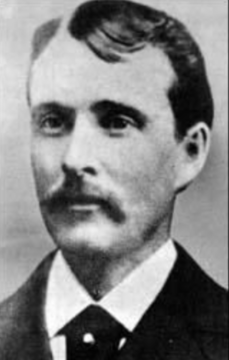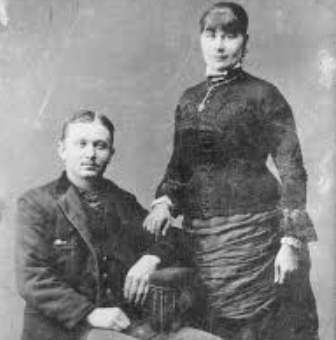by Mark Harvey
In the afternoon I went to where my Ella was strangled to death, and saw the limb of the tree over which the rope was thrown. The bark is abraided and plainly shows the mark of their fiendish work.—Thomas Watson, 1889

In western newspapers from the late 19th century and early 20th century, it’s clearly evident that “justice” was often summary without any form of trial. The sentences meted out for crimes, real or imagined, often involved a rope. On the front page of the July 30, 1889, Delta Independent, a Colorado newspaper still operating today, there’s a story titled “A cattle thief and his paramour hung from a cottonwood.” The “paramour” was one Ella Watson described in the paper as “…a woman of notorious character, a dead shot with a rifle, and of revengeful disposition….” The “cattle thief” was Jim Averill, a store owner, notary, justice of the peace, surveyor and partner of Watson.
The story describes the Wyoming couple as notorious and successful cattle thieves. Clearly sympathetic to the vigilantes, it reads,
Last evening about twenty of the most respectable and law-abiding people of the Sweetwater Valley met near Averill’s Ranch. Averill and the woman were secured. A short hearing was given them and they protested that the calves in the pasture were brought from Nebraska. This was disproved without further parley. Ropes were placed around their necks and thrown over the limbs of a spreading cottonwood.
Whether or not Averill and Watson were the thieves claimed by the vigilantes is of some dispute and will never be proven one way or the other. But Tom Rea’s excellent book Devils Gate, Owning the Land, Owning the Story casts real doubt on the issue and suggests that Averill and Watson were just small landowners, general store operators, and aspiring ranchers who got in the way of bigger players. The two had applied for a marriage license in Lander, Wyoming, but it’s uncertain whether or not they were ever legally married.
Of the six men in the posse that ran down and hanged Averill and Watson, three were ranchers with large holdings in the area and one had intentions of starting a town near Averill’s general store—and ultimately bringing in a railroad. Their claim was that Watson had stolen cattle from their ranches. She held that her cattle were footsore animals bought from immigrants on their way to Washington State.

Averill had served in the army for several years, was running a small but successful general store, and had made land claims of a few hundred acres near the Sweetwater River. He had applied for a cattle brand numerous times with The Carbon County Brand Committee but had been turned down repeatedly. Owning a cattle brand was particularly important in those days because maverick cattle—those unbranded and unclaimed cows were gathered and sold at auction by the Wyoming Stockgrowers Association. But to buy maverick cattle a person needed a registered brand.
Ella was an independent woman and did a lot of things women in Wyoming weren’t doing in that age. She owned a couple of hundred acres of land from making a homestead claim, but perhaps more impressively she had her own cattle brand. After being rejected by the Carbon County Brand Committee on her own brand application, she simply bought the LU brand from another rancher. Then she accumulated a small band of cattle. Obviously an ambitious woman, she had also filed for rights to build a two-mile irrigation ditch for a hay crop. She was only 28 years old when she was hanged.
Ella’s father, Thomas Watson, learned about the hanging when he read the account in the Omaha Bee from his home in Nebraska. After postal correspondence to learn the details, he traveled to Wyoming in August to settle his daughter’s estate and seek justice. In a touching interview published in the September 23, 1889, issue of the Laramie Daily Boomerang, Ella’s father describes his daughter:
Her reputation was the best and she was always considered a splendid worker. She was a fine girl, of handsome form, strong and rugged, weighing from 165 to 170 pounds, but modest and unassuming, with not a particle of nastiness in her action and disposition.
After settling Ella’s estate, Watson went to the lynching site to see for himself the tree from which his daughter was hanged. The tree was only two miles from Ella’s ranch but some 700 miles from her father’s home in Nebraska—a galactic journey in those days. Watson tried to confront Albert Bothwell, one of the members of the lynching party and the man intending to start a new town, at his own ranch but couldn’t find him.
Newspaper accounts and editorials after the hangings ranged from defending the vigilantes as upstanding, law-abiding men who simply couldn’t get justice through the courts to those calling the vigilantes murderers and the act a black stain on Wyoming. An account in the August 29, 1889 issue of the Laramie Boomerang describing the lynching reads, “It was a disgraceful affair, a foul stain upon the territory….if the authorities earnestly endeavor to sift this foul outrage to the bottom and do their utmost to bring the perpetrators to justice the fact will be recognized in other sections of the country that the people of Wyoming as a whole do not uphold lawlessness and do not condone crime.”
The hanging party was arrested in Carbon County and tried for murder. The jury foreman was I.C. Miller, a sheep grower. As the trial approached, two key witnesses disappeared and one left the state for Steamboat Springs. With no eyewitnesses, all six men were acquitted. Bothwell, the man sometimes cited for organizing the hanging party went on to acquire both Averill’s and Watson’s land.

There are a couple of remaining photos of Ella Watson, one taken when she was around 18 years old with her first husband and another of her up on a big horse. In both photos, she appears to be wearing a corset. A corset is about as restrictive a piece of clothing as you can imagine and only slightly less confining than a chastity belt. That a woman who had her own homestead claim, her own cattle, her own brand, and plans to build a two-mile irrigation ditch wore a corset says something about the contradictions of the times. For it was Wyoming that first gave women in America the right to vote and it was Wyoming that had the first female governor in America, Nellie Tayloe Ross.
The image of Watson up on her big horse in a full-length dress wearing a corset captures her predicament, clearly a capable pioneer but still bound by restraining traditions.
Corsets have been worn by women since the Minoan civilization, which means that for thousands of years, women have been wearing a very uncomfortable undergarment to give a desired shape to their figures. Many of the newspapers describing the open-range justice of the Wyoming hanging tree in those years toward the end of the nineteenth century advertise corsets of every style and every shape. Some American papers had women writers waxing on and on about their attachment to the corset. In a piece in the November 7, 1897 issue of The Philadelphia Enquirer, one Anne Smith writes,
We are proud to assert our superiority over women of the last decade….we golf and wheel and skate and go a-hunting like modern Dianas, yet the most progressive woman of us all clings to her corset long after she has discarded thin shoes and unbusiness-like habits. She may doff it on occasion and she delights to show that her firm muscles really need no support, but she has not yet come to the point of going to a ball corsetless and she never will…
It gets better! Smith goes on to write in the same piece,
One usually associates with an uncorseted figure…square, gaunt women with penchants for voting, and the ideas are not inspiring. It is such a pity that reforms are nearly always presented in unattractive guise. No one wants to be good and ugly and dress reformers of rabid notions have done far more toward drawing corset laces tighter than they have toward cutting them.

One of the things often advertised in American newspapers at the turn of the 19th century is the Warner rust-proof corset. I had no idea that rust was an issue with corsets and when the ribbing of corsets was made out of whalebone it wasn’t an issue. In the 19th century when the whalebone was replaced with metal ribs, apparently rust became a problem. I assume the rusting came from perspiration.
The variety of corsets available in the late 19th century is amazing. There are nursing corsets, long-waisted corsets, embroidered bust corsets, abdominal corsets, high bust corsets, and more. They generally cost between 75 cents and a dollar.
When you read these old ads for corsets you might chuckle and tut-tut at the absurdity of trying to force your figure into a certain shape with a garment so well constructed that it would make a civil engineer blush. But I’m not sure we’re much beyond corsets. They’ve lost their steel parts, yes, but the revenue of Spanx, the shapewear with catchy names such as “Bod-a-Bing” and “Hide and Sleek,” was close to half a billion dollars last year. The one thing new with Spanx: men now get to share in cramming their bodies into shapeshifting garments.
Well before Ella Watson was hanged, the popular writer Elizabeth Stuart Phelps urged women to burn their corsets, bespeaking the burn-the-bra movement of the 1960s and 1970s. In 1874 she wrote,
Burn up the corsets! … No, nor do you save the whalebones, you will never need whalebones again. Make a bonfire of the cruel steels that have lorded it over your thorax and abdomens for so many years and heave a sigh of relief, for your emancipation I assure you, from this moment has begun.
I’m not sure parallels can be drawn between corsets, Ella Watson’s hanging, and the death of Masha Amini, the Iranian woman arrested for wearing her hijab incorrectly. A bit of a stretch perhaps. But even if wearing corsets wasn’t enforced by a group as brutal and murderous as Iran’s morality police, the pressure on women to taper their waists into hourglasses must have been intense.
Having read a number of 19th-century accounts of the hanging of Ella Watson, I’m convinced she wasn’t hanged for being a cattle thief but instead for trying to homestead among the big operations of neighboring stockmen. She was called all sorts of things—notorious, profane, and loose. But her history of responsible employment, the legal steps she took to get a land claim and a cattle brand, her plans to irrigate a meadow for hay, and her close contact with her father in Nebraska speak more of a brave young woman trying to make a go of it in some of the toughest country in America. It was her way of escaping the traditions and limitations represented by the corset worn by so many women of that place and that time.
